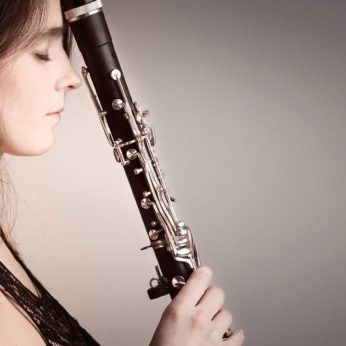Composer: Carl Maria von Weber (b. 1786 - d. 1826)
Performance date: 05/07/2016
Venue: St. Brendan’s Church
Composition Year: 1811-15
Duration: 00:23:46
Recording Engineer: Richard McCullough, RTÉ lyric fm
Instrumentation Category:Clarinet Quintet
Instrumentation Other: cl, 2vn, va, vc
Artists:
Borusan Quartet (Esen Kıvrak, Olgu Kızılay [violins], Efdal Altun [viola], Cağ Ercağ, [cello]) -
[quartet]
Annelien Van Wauwe -
[clarinet]

We owe much of the clarinet repertoire to
great composers meeting with great clarinettists. Thus we have Mozart and Anton
Stadler, Brahms and Richard Mühlfeld and Weber and Heinrich Bärmann. Weber wrote
several works for Bärmann, who played in the Court Orchestra at
role as conductor met him and fell for the warmth and richness of his playing
as well as his spellbinding virtuosity. In
the early nineteenth century the clarinet was being rapidly developed and
Bärmann played a special ten-key clarinet made for him by Griesling and Schott.
In the period 1811-16 Weber wrote six substantial works for Bärmann. The
Quintet was written in instalments over four years, movement by movement, and
as soon as Weber finally finished the last movement, Bärmann premiered it the
very next day.
The work opens with fifteen bars of slow
introduction for the strings alone before the clarinet’s entry ushers in the
main Allegro with its two bewitching themes. Both themes show a fondness for
lilting dotted rhythms and both continue with passage work for the clarinet
that is virtuosic rather than purely melodic. Clearly Weber was more concerned
at displaying the qualities of Bärmann’s playing rather than with writing a
work of intimate chamber music such as Mozart and Brahms both wrote. The
movement closes with a sudden display of seriousness in an intense and strongly
worked coda.
The G minor Adagio is entitled Fantasia and here the cello is given the
privilege of introducing the clarinet’s gloriously rhapsodic aria. The
movement’s progression is twice interrupted to electrical effect by the
clarinet’s twofold chromatic scales – first fortissimo
then pianissimo possibile. The
sparkling Scherzo takes off in great style with a rocketing figure in the
clarinet, wittily answered by chugging strings and much play is made of this
idea with the addition of cross-rhythms and
clever syncopations. The legato Trio returns us to the lyricism of the slow
movement with the strings allowed some brief moments in the limelight before
the clarinet picks up the disarming melody. However the Scherzo soon returns
and the mood is gone. The finale is a breezy rondo replete with good tunes and
with a relentless rhythmic drive. As in the coda of the first movement, there
is a brief suggestion of more serious matters in the development, but this is
only a momentary aberration and the clarinet soon resumes its carefree course,
concluding with yet another stunning virtuoso performance.
Copyright © 2025 West Cork Music. All rights reserved.
Designed and developed by Matrix Internet